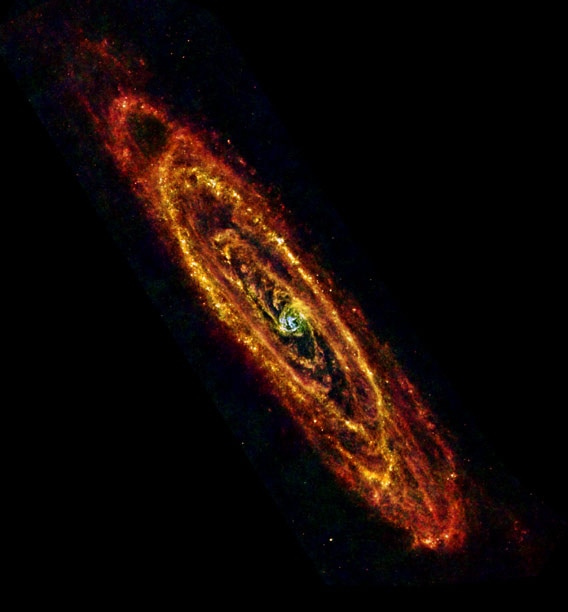Create a free profile to get unlimited access to exclusive videos, sweepstakes, and more!
The Cold, Dusty Arms of Andromeda

I know I just posted an image of a nearby spiral galaxy that combines optical and infrared light. But by coincidence another picture just came out, and it shows the far more famous Andromeda Galaxy, and itâs a jaw-dropper:
Yegads. And yeah, you want to see this in all its full-res glory. This was taken by the European Herschel observatory, which sees in the far-infrared. Like, really far: Whatâs shown here as blue is actually IR light with a wavelength of 70 microns, a hundred times the reddest light our eyes can see; green is 100 microns, and red is a combination of 160 and 250 microns. The wavelength of light an object emits corresponds to its temperature, so the material you see as red in this image is at a frigid -261°C (-439F). The warmest material you see in the picture is at -232°C (-385°F). To give you an idea of how cold that is, at that temperature the oxygen in our air would be frozen as hard as rock.
Andromeda is a spiral galaxy much like our own Milky Way, though physically bigger. Itâs also the closest spiral to us, so itâs intensely studied. Unfortunately, itâs tilted with respect to us by only about 13°, so itâs nearly edge-on. That makes it hard to study, because a lot of the material in the front of the galaxy blocks whatâs behind it.
But thatâs when you look with an optical telescope. What astronomers call dust is made of lots of different molecules, and is opaque to the light we see. But that cold dust glows in the infrared, so using Herschel allows us to see all of it. Most of the dust, as expected, follows the spiral pattern of the galaxy. Since dust is created when stars are born and when they dieâand this happens in the spiral arms for the most partâthatâs where the dust is too.
But also revealed in this image is a large ring of dust (the brightest ring in the image) about 75,000 light years in radius. That may have been formed when Andromeda collided and merged with a smaller galaxy; Andromeda stripped that ill-fated galaxy of its dust, which settled into that ring shape. There are several rings of dust in the picture, so if the merger idea is correct it means Andromeda has been pretty hungry over the past few hundred million years.
A far-infrared image of Andromeda by Herschel was released a couple of years ago, but this one has higher-resolution, and also includes the warmer dust (shown in blue and green) in the galaxyâs heart. As you can see, this dust still traces the spiral pattern, all the way down to the very core of the galaxy. Things get a little messy, though, with the pattern getting a bit chaotic. Thatâs not too surprising: Hubble observations show that the very center of Andromeda has a lot going on; there was a burst of star formation a couple of hundred million years ago, and there are packs of stars circling the core. Also, every big galaxy has a supermassive black hole at its very center, and Andromeda is no exception: The monster there has a mass at least 30 million times that of our Sun, and may be as much as 100 million times as massive. Thatâs at least ten times the mass of the corresponding black hole in the center of the Milky Way.
The Andromeda Galaxy is about 2.5 million light years away, but so huge that itâs visible to the naked eye (as I write this, in January, itâs in the southwest just after sunset for Northern Hemisphere observers), though binoculars are probably needed in even mildly light-polluted skies. I have seen this galaxy myself literally hundreds of times through all manners of optical instruments, so images like this really appeal to me; I love seeing something old as if itâs new again.


























